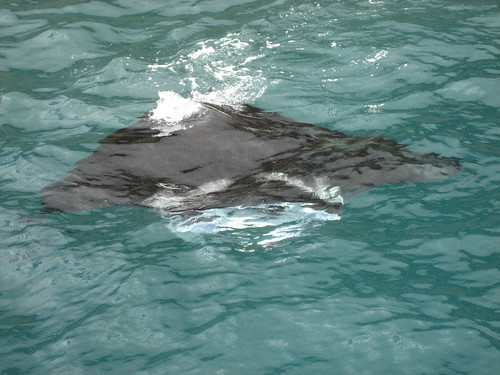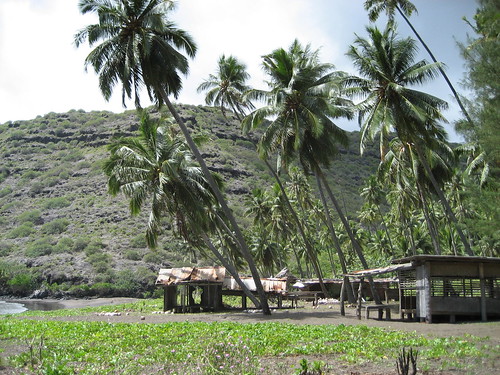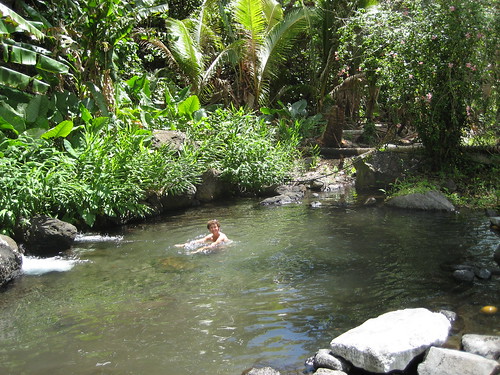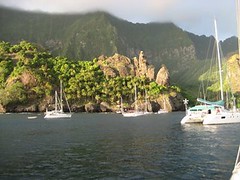We have not written an entry in our blog for nearly a week now,
so here goes. We also found that one of Mark’s entries (labeled
Hiva Oa and Atuana) did not post on time, so if you want to
check it out go back two blog entries.
Saturday and Sunday (May 19th and 20th) :
Last we wrote we were in Hanamenu on the island of Hiva Oa. We
spent two nights there before moving on to the next anchorage in
Haniapa Bay. The two bays are very close together ( about 12
nm), but the wind was right in our face to get there, so we
decided to do a wide tack to get there so we could get some
sailing in. It was beautiful, but just before we arrived in the
bay, there was a huge unexpected wave, or trough that we hit –
we are not sure what- and the whole boat shook violently. The
outhaul on our tightly sheeted mainsail snapped, making the
mainsail flog freely and uncontrollably in the wind. It was no
big deal to furl it in until we could get to the anchorage and
fix things. The outhaul is the line that you use to pull out the
sail along the boom ( and pull it back as well). Luckily Mark
had purchased an extra outhaul for the sail and we knew it was
readily available, and we knew that we would be able to fix the
sail once we dropped anchor. Haniapa Bay is supposed to be the
most protected anchorage on the northern coast of the island,
and while that may be true, it was nonetheless a very rolly
anchorage the nights we were there, but it was extremely beautiful.
The first night we were there we were the only boat in the
magnificent bay. Lots of manta rays in the water – but a
different kind than we saw in Hanamenu. These were brown and
white rather than black and white, and they did not venture
quite as close to the boat as the ones in Hanamenu did. In the
morning, after a rainy night, with lots of uncomfortably choppy
water in the harbour, we took our kayak in to town. The town has
both a wharf and a beach that you can land on, depending on the
tides and the conditions. We started out by taking our kayak
into the beach. Haniapa Bay has a village with about 20 houses
and roughly 100 inhabitants. It is not a poor village and in
fact it rather looks about as much as you might expect a village
in the Garden of Eden to look. It is a rainy part of the island
and everything was so green and lush with hundreds of blooming
flowers, colorful leafy plants, and more fruit trees than you
can imagine. Everyones home was set amidst gorgeous foliage.
Mark took some pictures of the fruit that we hope to post on the
website soon.
Since there were no stores or restaurants, we decided we would
try to buy some fruit or trade with the locals. A 12 year old
boy decided he would be our guide in the village and help us get
fruit. He started throwing rocks and hard mangoes up at the
mango trees to knock some fruit off for us, and snuck a few
papayas off of some trees which were clearly not his. We
decided we would try to get fruit in a less furtive manner and
when we walked by a house filled with people all sitting
together eating lunch, we asked them if we could get fruit. No
problem they said , and asked us what we were interested in.
Bananas, mangoes, and pamplemousse (pomelos) were high on our
list. The man of the house said we should come down to the
beach later and he would have the fruit ready for us in
exchange for a t-shirt and a lipstick that we would give him at
the dock at 5:00. So we continued our walk through the lovely
village.
A few minutes later we saw a very crudely written sign for the
Hanaipa Yacht Club. We didn’t see anyone around, and certainly
didn’t see any structure that looked like a yacht club, but just
a minute later a very funky character popped out of the back
and introduced himself as William the head ( and sole member)
of the yacht club. Apparently he tries to meet every boater who
comes into the bay invites them over for a glass of lemonade
and bananas and has them write something into his scrapbook.
We obliged and enjoyed talking to him on his very mosquitoey
porch. He was an older man (although it is really hard to tell
exactly how old), wearing a very old and worn t-shirt and
shorts, with a fairly long grey beard, tied neatly into a
ponytail in the front. He has apparently been collecting cards
and signatures from yachters for 30 years, and just recently his
home burned down with all of his scrapbooks. He just recently
started a new scrapbook, and we were only about the 20th visiter
to sign it and we recognized the cards of some of the other
boats that had visited him. He told us he would bring some
bananas and fruit down to the dock for us later as well and
asked if he might come see our boat. We arranged to meet him at
4:00 at the dock and continued our walk. Our 12 year old friend
was still with us, enjoying the candies that we had brought
along with us. Then we came upon a beautiful mango tree just
filled with wonderful looking fruit. We asked the owner if we
could buy some , and after filling one of our bags with them ,
we asked him how much, but he said they were free and then he
added a few grapefruit.
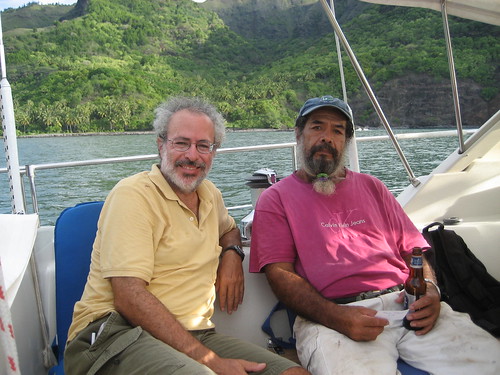
We figured by then that we were going to have more fruit than we
could handle so we finished our tour of the town, and went back
to the beach. All of the town was getting together for a party
at the church, but we didn’t feel like it was the kind of event
that we should crash, so we just went to see what kind of fruit
was waiting for us. Our friend had really prepared a bonanza
for us – there were two huge stalks of bananas ( each with about
60 bananas), one huge stalk of plantains, a mountainous sack of
pomellos, plus several papayas and guavas. We couldn’t even
think of carrying it back on the kayak, so we left it on the
beach and paddled back to the boat.
In the meantime, we could see our friend William, standing by
the wharf waiting for us, so we dropped off the kayak, set up
the engine on the dinghy (always a pain in the but task), and
went to pick him up. He had brought some limes, another huge
stalk of bananas, and a very strange looking fruit , a soursop.
William came on board and was more than pleased to have a beer
and some peanuts and we gave him one of Mark’s t-shirts and some
Advil which he needed for his sore back. He was a little
disappointed not to walk away with a bottle of whisky, but very
pleased to have added another yacht to his list of friends.
So, now it was getting late and we had to go get our fruit. We
took the dinghy back to what had been a beach just two hours
before, but which, at high tide, was no longer a sandy beach,
but just some steep rocks. We dropped William off in a hurry and
tried unsuccessfully to hold the dinghy steady so we could pick
up the fruit, which was sitting in a beached fishing boat, but
the surf was too strong. So we headed back over to the wharf
where we thought we could tie up easily, walk the 400 meters
back along the beach to pick up our fruit, and finish up our
shopping.
It was not that easy, however. We did manage to tie up to the
concrete dock, but it was rolly and hard to tie up and clamber
up the rough sides to the top. Then we started walking back
along the shore, but found that there was a small river in the
way! I didn’t want to cross it, but the alternative was to walk
about a mile around through town, and back to the beach. Since
it really was quite shallow we crossed easily and were finally
able to pick up the fruit that had been left for us. We took as
much as we could carry, but had to leave behind a stalk of
bananas and a stalk of plantains. Mark must have had 50 pounds
of pomelos on his back. Finally back at the wharf, we realized
it was already close to 5:00 and our friend should be by soon to
pick up his t-shirt (which he had changed to asking for 2
t-shirts at the last moment). We waited a bit, but then,
knowing it was getting dark, and that we still had to lift up
the dinghy and engine in preparation for our departure planned
for 3:30 a.m , we decided to just leave the goods for our friend
on the wharf in a plastic bag hoping he would come by soon and
get them. We got back to the boat where we had a clear view of
the dock, but he never came. We felt very bad, but hoped that
the bag would still be there when and if he came by.
Monday May 20, 2007
We got up at 3:30 a.m. to start our trip to Nuku Hiva. The best
time to leave in order to arrive during daylight hours was
between 3:00 and 4:00 a.m.. It is really a nice time to sail.
We managed to get several hours of sleep before we pulled up
anchor, and the sky was clear with lots of stars as we sailed
out of Haniapa Bay at 4:00 a.m. It was not long before there
was light in the sky, and we had an easy and relatively fast
sail arriving in Nuku Hiva just about 5:00 p.m. It is another
gorgeous bay , very large, surrounded by green volcanic
mountains. There were a lot of boats in the harbor , probably
30 or more. We were pleased to find that our friends on Vera,
Rishu Maru and Yara were all there, and we found a convenient
place to anchor right near them. Lots of other boats there that
we had seen along our journey as well. We were greeted by
Britta and Michael from Vera, and then Mark and I set up the
dinghy and engine and went into town. The town here, Taiohae,
is the largest city in the Marquesas and is the administrative
capital population- a teeming 1,500. We were hoping to find a
good restaurant, but found pretty slim pickings. The only
restaurant we passed had a couple of very bored looking yachties
who looked as if they had been sitting there for a long long
time. The menu was expensive and the waitress was kind of surly
so we decided we would join the group of locals standing by a
white truck that was clearly serving food. The chef, was a
Chinese man, and he was cooking up a storm, cooking up an
unbelievable amount of food and working so fast we thought he
would have a heart attack before the night was out. His wife
worked next to him, frying up a couple of wok dishes, while he
managed the bbq picking up meat with his bare fingers
from the flame tossing them onto the dishes filled with rice,
pouring on some type of barbeque sauce and a couple pieces of
bread, and slapping on some saran wrap. It really was an
amazing operation. We ordered a couple of dishes and then sat
on the adjoining steps of the local supermarket, enjoying the
food and the scene.
Tuesday and Wednesday, May 22nd and 23rd.
Although the town of Taiohae was very small, there were a few
nice facilities for us there including wireless internet
service that we could get from the boat. We were able to use
Skype to talk to Hannah, Ben and our friend Robin Ringer. We
couldn’t get any video of the kids with Skype, but were able to
clearly see Robin ( who got up at 1:30 a.m. to answer our Skype
call!). Very cool. Other than the internet we just spent a few
days gathering groceries, and visiting with our friends.
Wednesday was a big day in town as the supply ship came in ,the
same one we had seen 3 weeks ago in Fatu Hiva. It was a welcome
arrival as the two grocery stores were pretty much out of all
fresh produce, cheese and yogurts. (You can see that our trip
is pretty much about getting food). The ship brought in some
useful food supplies. There were supposed to be beautiful hikes
from town, but it was so hot that we didn’t do any of them. We
hope to do more hiking and sightseeing when Mia and Hannah come
in a few weeks.
On Wednesday night we hosted a pot-luck dinner on our boat. We
supplied the fresh tuna, and Britta prepared an amazing huge
plate of sushi and sashimi. Alex (from Rishu Maru) brought
chili-con carne, and Gesche (from Yara) brought guacamole and
corn-bread. We had a huge feast while the two kids sat below and
watched “Finding Nemo”.
Thursday, May 24, 2007
Another supply boat came in this morning so we finished up our
provisioning. I think we freaked the grocery store owner out
when we asked him for 4 cases of diet-coke. It is terribly
expensive here, but it is one drink that we really enjoy when it
is blazing hot out ( as it usually is). We loaded up with
cokes and cheeses, picked up our laundry, got some cooked curry
for lunch, and then got ready to leave the bay. We had to leave
as the bay was not clean enough to make water and our water
supply was running low. Just as we were getting ready to leave
we realized that the new boat that had anchored near us was
“Irie”- a boat owned by Christian and Paukie, whom we had
met just before leaving Fatu Hiva . We talked to them on the
radio and they said they had just caught a 5 foot wahoo ( a
fish), and since they couldn’t possibly eat it all they wanted
to know if we wanted some. We did, but already had everything
put away for the sail and could not dinghy over. They said just
to motor by on our way out and they would toss us a package of
fresh fish. So, they tossed it, we caught it, and now we can
finally say that we have “caught fish”! We then set sail for
the nearby Taioa Bay – known locally as Daniel’s Bay. Daniel
was a Marquesan who lived here forever , welcoming sailers, and
keeping an extensive guest log. Apparently Daniel died last
year, but the bay is still beautiful and calm, and it is a nice
place to spend a few days. Our other boat friends are all here
as well.
L.

